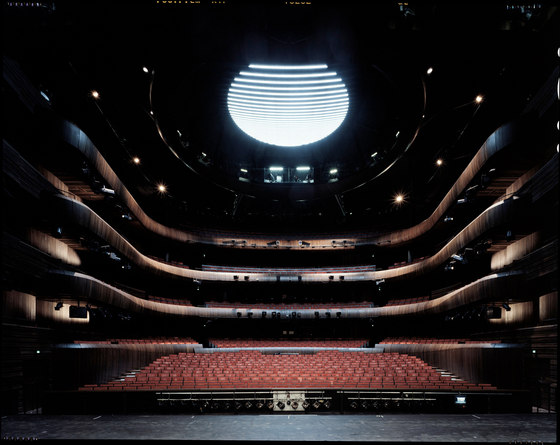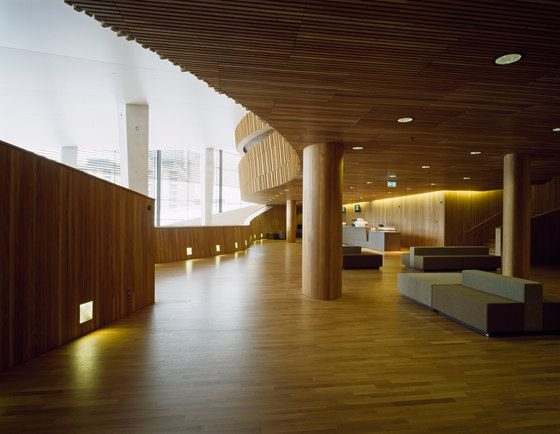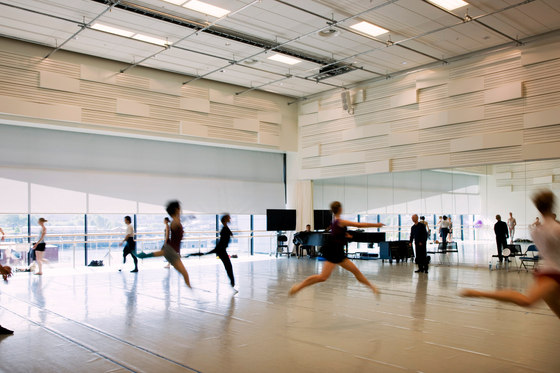Snøhetta’s prize-winning design was characterized by the jury as having strongly identifiable themes that tie the building to its culture and place while also presenting an unusual and unique expression that was in many ways new and innovative. The project developed a highly complex program into a simple general plan that integrated both a practical and intuitive sculptural approach to modeling the exterior form.
Its low slung form became a link within the city rather than a divisive sculptural expression. Its accessible roof and broad, open public lobbies make the building a social monument rather than a sculptural one. The building is as much landscape as architecture and thus fosters public awareness and engagement with the arts. Generous windows at street level provide the public a glimpse of the scenery workshop activities.
The building still finds an audience with public who are not opera, ballet or orchestra fans. The cafes and gift shop, with their access to the waterfront are destinations which offer opportunities to generate revenue for the institution while providing a general public amenity.
Care was taken with the design of these components so that they are seamlessly integrated into the overall character of the building’s bold design. The opera house is the realisation of the winning competition entry. Four diagrams, which were part of the entry, explain the building’s basic concept.
”The wave wall”
Opera and ballet are young art forms in Norway. These art forms evolve in an international setting. The Bjørvika peninsula is part of a harbour city, which is historically the meeting point with the rest of the world.
The dividing line between the ground ’here’ and the water ‘there’ is both a real and a symbolic threshold. This threshold is realised as a large wall on the line of the meeting between land and sea, Norway and the world, art and everyday life. This is the threshold where the public meet the art.
”The Factory”
A detailed brief was developed as a basis for the competition. Snøhetta proposed that the production facilities of the opera house should be realised as a selfcontained, rationally planned ‘factory’. This factory should be both functional and flexible during the planning phase as well as in later use.
This flexibility has proved to be very important during the planning phase: a number of rooms and room groups have been adjusted in collaboration with the end user. These changes have improved the buildings functionality without affecting the architecture.
”The Carpet”
The competition brief stated that the opera house should be of high architectural quality and should be monumental in its expression. One idea stood out as a legitimation of this monumentality: the concept of togetherness, joint ownership, easy and open access for all. To achieve a monumentality based on these notions we wished to make the opera accessible in the widest possible sense, by laying out a ‘carpet’ of horizontal and sloping surfaces on top of the building.
This carpet has been given an articulated form, related to the cityscape. Monumentality is achieved through horizontal extension and not verticality. The conceptual basis of the competition, and the final building, is a combination of these three elements – The wave wall, the factory and the carpet.
Urban situation
The opera house is the first element in the planned transformation of this area of the city. In 2010 the heavy traffic besides the building will be moved into a tunnel under the fjord. Due to its size and aesthetic expression, the opera house will stand apart from other buildings in the area.
The marble clad roofs cape forms a large public space in the landscape of the city and the fjord. The public face of the opera house faces west and north – while at the same time, the building’s profile is clear from a great distance from the fjord to the south.
Viewed from the Akershus castle and from the grid city the building creates a relationship between the fjord and the Ekerberg hill to the east. Seen from the central station and Chr. Fredriks sq., the opera catches the attention with a falling which frames the eastern edge of the view of the fjord and its islands.
The building connects city and fjord, urbanity and landscape. To the East, the ‘factory’ is articulated and varied. One can see the activities within the building: Ballet rehearsal rooms at the upper levels, workshops at street level. The future connection to a living and animated new part of town will give a greater sense of urbanity.
Landscaping
The opera’s landscape comprises of the marble roof, additional marble clad areas, and the areas between the building and the surrounding streets. Access to the plaza and the main entrance is over a marble clad footbridge over the opera canal. The plaza forms a part of a public promenade and cycle lane which continues around the west and south sides of the building, and eventually coming to a planned bridge over the Aker River to the east.
As early as the competition entry, Snøhetta proposed that the roof scape should be openly accessible to the general public and that it should be clad with white stone. Today the building’s defining feature is the characteristic geometry of the roof as it rises from the fjord and is laid out like a carpet over the public areas.
An important move has been to introduce channels along the roof edges with ramps and steps. This allows the integration of regulation height balustrades with raising the line of the roof itself. To achieve enough acoustic volume in the auditorium, the roof has been raised independently inside the line of the balustrades.
This has created a new viewing point from which the city and the fjord can be experienced. The roofs are mostly too steep for wheelchair use but access to the near flat, upper areas is provided via a dedicated elevator. The surface treatment of the stone, its pattern, cuts and lifts which create a shadow play have been designed in close collaboration with the artists.
The white marble is ‘La Facciata’ from the Carrara quaries in Italy. The north facade and all the stone cladding which is in contact with water is a Norwegian granite called ’Ice Green’. Prototypes and tests at full scale were studied at the contractor’s facilities before the final choices were made for colour nuance and surface texture.
A running quality control regime has been implemented throughout the production process. Adjacent areas During the building period it became clear that rapid and considerable settling of the ground level around the building would need to be addressed. Large areas of gravel which is designed to take local vehicular traffic have been laid around the building footprint.
This is easy to adjust as the ground sinks relative to the building which is founded on the bedrock. Trees are planted in the gravel areas, and a zone of street furniture is located along the pavement line with cycle parking, benches and specially designed streetlamps in stainless steel.
The pavements are of asphalt with black granite edges and larger areas of granite paving to highlight the entrances to the restaurant, opera street, and stage entrance. The dark grey colour palette is a clear contrast to the light stone and aluminium of the building itself within a cool monochrome language.
Landscaping of the surrounding areas has been designed in collaboration between Snøhetta and Bjørvika Infrastructure who have been responsible for the planning of the street around the opera house.
Courtyard
The courtyard is a garden in the middle of the production area of the building, surrounded by facades of black glass, aluminium and timber and open to the sky. There is direct access to the courtyard from ground and basement levels while the upper levels experience it as a green lung deep inside the building.
In front of the sound insulated rehearsal rooms at basement level, vegetation has been planted to form a screen. The floor of the courtyard is a composition of timber decking, white marble, and green areas. A marble clad stair connects the two levels. Grasses, climbing plants and perennials are planted around clusters of cables reaching up to the upper levels and providing shade to the facades.
Statsbygg (The Governmental Building Agency)
Snøhetta

























